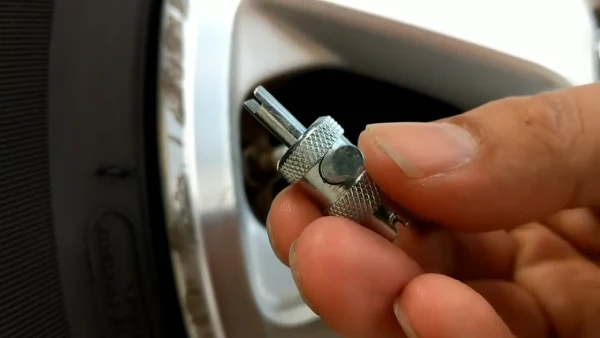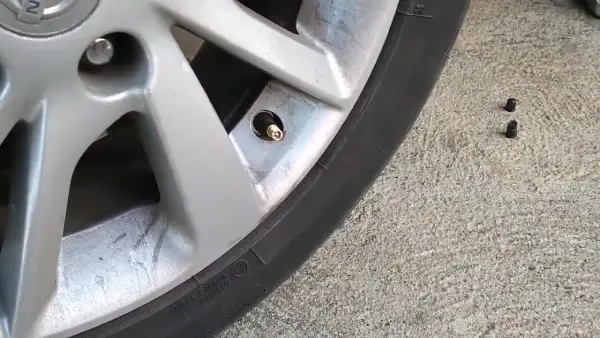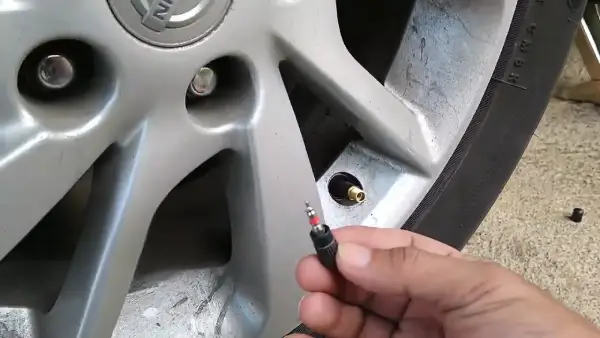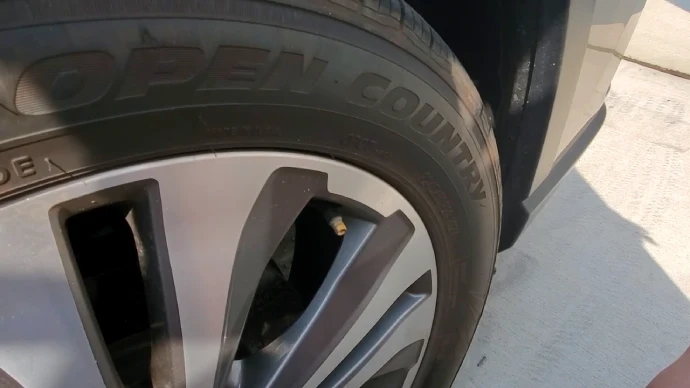Last Updated on April 11, 2023
Do you want to save time and avoid the danger of jacking up your car every time you need to change a valve core? Do you want a simple and efficient solution to this problem? The idea that you need to jack up your car to change a valve core is a common misconception.
You do not need to jack up your car for each valve core change. In fact, jacking up your car is not even necessary for this simple task. So, what do you need instead? All you need is a valve core tool, which is a small and inexpensive tool designed specifically for removing and installing valve cores.
These tools are easily obtainable and can be found at any auto parts store. With a valve core tool, you can easily change a valve core without the hassle of jacking up your car. In this discussion, we’ll show you how to turbocharge performance and extend life spans with step-by-step guidance.
Change the Car’s Valve Core without Jacking Up Your Car: Guided Instructions

Changing the car’s valve core without jacking it up is a relatively simple process that can be done in just a few steps.
Step 1: Locate the Valve Core
The first step in changing the valve core is to locate it. The valve core is on the tire’s stem, usually near the wheel rim. It looks like a small metal cylinder with two slots cut into it.
Step 2: Remove the Old Core
Once you have located the valve core, you will need to remove it using a special tool called a valve core removal tool. This tool has two ends, one with a slot and one with an Allen wrench head. Insert the slot end of the tool into one of the slots on the old core and turn counterclockwise until it pops out.
Step 3: Install New Core
The old core must be removed before installing a new one. The new core should be inserted into a slot on the tire’s valve stem and turned clockwise until it is securely in place. Make sure not to over-tighten, as this can cause damage to both the tire and wheel rim.
Step 4: Check for Leaks
After installing your new valve core, check for leaks before driving your car again. Inflate the tire to its recommended pressure level. Wait several minutes to check for air escaping from around the new valve core or any other part of the tire. If there are no leaks, then you are ready to drive.
Why Cars Should Not Be Jack-Up For Valve Core Replacement?

It is not recommended to jack up any cars to change the valve core of that car because it can be dangerous and lead to serious injury or even death. Here are some reasons why:
Reason 01: Jacks are designed to lift a car, not support it. Jacks can slip or fail, leading to the car falling off the jack and potentially crushing someone underneath it.
Reason 02: Even if you have a secure jack, you must make sure you use it correctly and on the correct part of the car. If you use an incorrect jack point, you could damage your car or cause injury to yourself or others.
Reason 03: You should always use jack stands when jacking up a car; they provide additional support and stability while working on your car. Without them, there is an increased risk of the car slipping off the jack and potentially causing serious injury or death.
Reason 04: When jacking up a car, make sure that you are using a flat surface such as concrete or asphalt. Never use dirt or gravel, as these surfaces can be unstable and cause your car to slip off the jack if not used correctly.
Reason 05: Finally, when changing a valve core on any car, ensure you have all the necessary tools and safety equipment available before beginning work on your car. This includes gloves, eye protection, wheel chocks, and other items that will help ensure your safety while working on your car.
Changing The Valve Core Of A Car: Why?

01. Improved Performance And Power Output
Changing a car’s valve core can significantly improve its performance and power output. The new valve core will allow more fuel to be supplied to the engine, resulting in increased combustion efficiency and improved engine torque.
This will lead to an increase in horsepower, allowing for quicker acceleration, better steering control, and higher maximum speeds. In addition, changing the valve core can also allow for more precise tuning of the engine for better overall performance.
02. Increased Fuel Efficiency
Replacing the existing valve core with a new one can result in improved fuel economy as well.
By allowing for more precise control over the amount of air that enters the engine, it can reduce the wastage of fuel and help to conserve energy while driving.
Furthermore, when combined with improved torque output, this can further improve a car’s mileage per gallon rating.
03. Smoother Engine Operation
When you change the valve core on your car, it helps to ensure smoother operation at all times by reducing wear and tear on internal components.
Optimizing combustion by adjusting airflow through the valve core helps prevent misfiring in cylinders.
This can lead to smoother acceleration and improved idling speeds at traffic lights or when going uphill.
04. Better Throttle Response
Replacing the old valve core with a newer, high-performance model can improve throttle response in a car.
Changes in the valve core design characteristics, such as size or shape, have improved airflow and combustion efficiency.
These changes have impacted air intake pressure and volume. Both of which can help provide quicker acceleration when needed.
05. Enhanced Overall Driving Experience
The car’s acceleration capabilities are improved due to higher power output and smoother engine operation. Throttle response is also enhanced with the replacement of old valve cores.
The gear shifting process becomes smoother, requiring less effort when controlling steering wheel turns due to optimized torque delivery. This provides excellent stability during sharp turns or lane-changing maneuvers on highways or city streets.
06. Decreased Emissions And Pollution
A changed valve core design in an engine improves combustion efficiency, leading to less smoke being emitted from the car’s tailpipe.
This reduces pollution levels released into the atmosphere and contributes to global efforts to reduce greenhouse gases such as CO2.
The use of cars can contribute to smog production in urban areas during the summer months. This smog has a negative effect on visibility and could lead to health issues if not addressed.
07. Extended Lifespan Of Engine Components
Installing a new valve core on your car can help extend its lifespan by allowing for better heat management of main components such as pistons, cylinders, and rods.
Having better control over air intake into each cylinder prevents accelerated deterioration or complete failure due to overheating during longer drives.
This also helps produce cleaner exhaust gasses that contain fewer contaminates, which would otherwise shorten life expectancy further if left unchecked long enough.
08. Improved Reliability And Durability
Installing a new valve core will improve reliability by eliminating misfires due to incorrect air intake measurements.
A fresh part means that it won’t have any pre-existing defects, preventing unexpected breakdowns and costly replacements in the future.
The longevity of the parts is extended with regular maintenance after installation.
09. Reduced Engine Noise And Vibration
The installation of the latest designed valve cores has improved combustion efficiency and decreased noise production from engines running.
This is noticeable no matter what type of speed or terrain, particularly at lower RPMs during idle periods such as stop signs.
Older models used to produce loud humming sounds during these times, but now they are barely audible due to advancements in newer models.
10. Enhanced Engine Safety And Protection
Replacing valve cores also enhances engine safety and protection from degradation. The new valve must be made of a material that is strong enough to endure temperature variations and other stresses.
This will ensure the valve does not malfunction or break during routine operation. Selecting an appropriate core size for your car’s engine type, you can ensure that all parts are correctly sealed at all times.
This helps reduce pressure losses, which can increase fuel efficiency while preventing damage to other components caused by leaking fluids. Finally, replacing worn-out valves with new ones will help prolong the life of your car’s motor overall.
What Are The Signs That I Need To Replace The Valve Core?

If you notice that your tire is losing air, it could signify that you need to swap out the valve core. Other signs include a slow leak, a hissing sound coming from the tire, or if the tire pressure drops quickly after being inflated.
Replacing the valve core is an easy fix and can be done in just five minutes using an inexpensive valve core tool and replacement cores.
How Long Does It Take To Change The Valve Core?
Changing the valve core on a car tire can take as little as 5 minutes. It involves jacking up the wheel, removing the old core with a valve core tool, and screwing in a new core. To ensure that all the air has gone from the tire, keep the valve depressed until all the air has been released.
Once this is done, you can insert the valve core replacement tool into the tire valve stem and rotate it to the left until it is released. AME INTL Quick Valve Change Tool can help open up an old valve so that you can completely deflate the tire.
Get Your Car Running Like New: The Overview
Replacing a car’s valve core can bring about many benefits – improved performance and fuel efficiency result, engine operation becomes smoother, throttle response is better, emissions and pollution levels decrease.
It also helps to extend the lifespan of engine components while improving reliability and durability. Furthermore, it reduces noise and vibration from the engine and enhances its safety.
Car owners should ensure regular servicing by qualified mechanics. Follow instructions for safe replacement without jacking up. Avoid potential risks or damages associated with this task.
